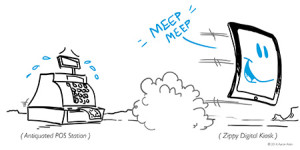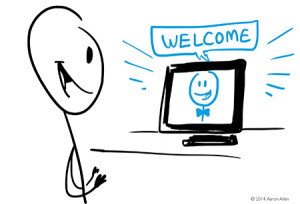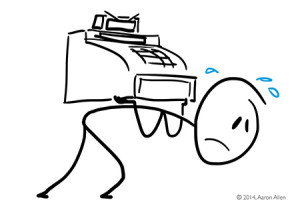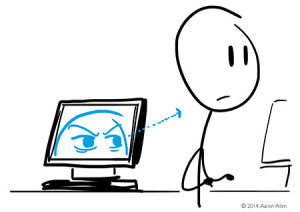Yesterday’s Restaurant POS is Dead; Here’s Why…
The digital revolution has been well underway for a few years, but it’s now evolving and affecting the restaurant industry in exciting ways few would have thought possible. Fortunately (or unfortunately, depending on your line of work), the old clunker POS (Point of Sale) system of yesterday has finally acknowledged and begrudgingly approved the writing of its own obituary.
In much the same way as the rotary phone existed along side touch-tone phones (or touch-tone phones still sold while mobile phones hit the market), the restaurant POS as we know it today exists alongside technologies that leave it operating embarrassingly deficient to the emerging technology of the day.
One trend technology buffs have been anticipating for a decade or more has now become a commercial reality – the self-service ordering kiosk.
It was only 2008 when I gave a speech in Europe that started off with a short clip from the Minority Report where Tom Cruise is recognized by his falsified eyeballs at the GAP, where a virtual reality retail associate suggests new product upgrades based on past purchases recalled on a retina scan. It was worth little more than a chuckle then (and considered ridiculously future-fantasy when the movie first came out), but we’re now there at the point where Orwellian fantasy meets commercial reality.
Just as POS replaced the cash register, the self-serve kiosk model with likely replace POS. The QSR business model is built on speed, efficiency (lower costs) and convenience, and the self-service model responds to all three.
Advantages of Digital and Self-Service Ordering Kiosks:
1. FASTER
 Nearly every aspect of menu production, deployment and analysis is made faster with new digital menus and touch-pad ordering systems. Think about what it was like in the old days of producing a magazine, for example. To get a magazine from the editorial calendar phase to being physically in mailboxes around the country (or world) took a tremendous amount of resources. Compare that to digital magazine production that skips the printing and fulfillment steps and goes straight from the editors’ desk to your iPad. The publisher saves time, money, and – should there be an error that needs to be corrected post-publishing, it’s a simple online edit versus printing apologies and retractions in the next printed issue.
Nearly every aspect of menu production, deployment and analysis is made faster with new digital menus and touch-pad ordering systems. Think about what it was like in the old days of producing a magazine, for example. To get a magazine from the editorial calendar phase to being physically in mailboxes around the country (or world) took a tremendous amount of resources. Compare that to digital magazine production that skips the printing and fulfillment steps and goes straight from the editors’ desk to your iPad. The publisher saves time, money, and – should there be an error that needs to be corrected post-publishing, it’s a simple online edit versus printing apologies and retractions in the next printed issue.
Now, put on your restaurant operations hat and imagine the challenges of printing and deployment of menus and new operational procedures/ordering protocol for a global restaurant chain like McDonald’s. While it looks like just one McDonald’s menu to the consumer, in fact there are thousands of menu variations (pricing, product, availability, etc.) for the McDonald’s system around the world. It’s easy to see the speed advantage of being able to localize and update menus from a central location electronically rather than through yesterday’s printed menus and POS systems that required local support/programming and associate training.
2. MORE EFFICIENT
 Touch-pad ordering is more efficient over yesterday’s POS system. A few examples include:
Touch-pad ordering is more efficient over yesterday’s POS system. A few examples include:
- Software can be updated more regularly and centrally which lowers costs
- The order confirmation is electronic, meaning paperless orders (electronic displays in back of house instead of printed tickets)
- Compliance is built-in (especially important for franchise organizations who have to constantly work to keep rogue franchisees from doing their own thing)
3. BUILT-IN SERVICE
The guest greeting is ensured, the upsells are built-in, the order confirmation is programmed, the guest/order appreciation is guaranteed, and you never have to worry about human error or oversight with regard to protocol or procedure on the part of staff. A computer can be programmed to always be cheerful and polite; line-level staff cannot.
4. RELEVANT/COOL FACTOR
There is a game-like appeal of these ordering systems for the early adopters. This means more media attention and word of mouth (especially among younger demographics important for QSRs).
5. MORE MEASURABLE
Again to use a publishing analogy, think of what it was like to measure the reach and effectiveness of print advertising as compared to the tracking and measurability of digital advertising. Now relate this to a restaurant menu and ordering. With a website you can measure every action (or lack thereof) for every single page and click on a web page. With touch-pad ordering, you can measure how long customers looked at each page/menu item, how long it took to order (and how long for every other step in the process from the preparation time to the receiving time) and time between orders/guest usage. You can roll up all of this data for real-time analytics to display on executive dashboards for any level of management (from a unit-manager dashboard to regional teams to the executive office view) with intuitive drill-downs management can access with their own touch-pad devices.
6. LOWER LABOR COSTS
The biggest cost for most restaurants (especially quick service) is labor; it’s either the #1 or #2 cost for any/every restaurant. If you can increase efficiency (particularly with the recent minimum wage debates and upcoming changes to overtime regulations), improve order accuracy, speed up throughput, ensure tighter operational compliance, get dramatically enhanced visibility, and enhance the guest experience – while simultaneously reducing your largest operational cost – why wouldn’t you pursue the technology that could enable it? And as restaurant chains are having this epiphany, they are doubling down on digital technologies. Some companies – like Starbucks, McDonald’s and Domino’s (and many of the other large pizza chains) – are betting the future of their companies on digital.
7. GREATER ACCURACY
When a guest verbalizes his order to a minimum wage employee in a busy and noisy restaurant, the chance of error is doubled. Sure, the associate should repeat back the order, but that doesn’t always happen. With touch-pad ordering, the guest enters the order directly and confirms the order him or herself on-screen. Guests don’t feel rushed and can take their time, thereby improving both order accuracy and guest satisfaction.
8. INCREASED CAPACITY
Given that labor is the #1 or #2 cost for a restaurant, labor cost and the sales per labor hour ratio must be monitored constantly, not to mention balance cost/service/capacity concerns in step with fluctuating demand. You will likely never see a McDonald’s with 10 cashier stations all staffed and operating at the same time. However, for less than the cost of a single week of labor for a single cashier, a touch-pad ordering station will work for free for years.
9. LOYALTY & MARKETING POSSIBILITIES
The possibilities here are endless and mindboggling. Let me paint a scenario: a guest approaches the kiosk and is recognized by a NFC (Near Field Communication) device. The system personally greets the guest and thanks him for returning, a past-order history is called up with one-touch repeat-order functionality, a personalization/recommendation engine (think the algorithm Amazon.com uses for its “Recommendations for You”) offers suggestions for new items or add-ons, the system articulates with other apps (for cashless payment, social media engagement, etc.). To conclude the order, the guest is thanked with an option to have the receipt emailed or texted right to their phone instead of printed. A status of the rewards/loyalty status is provided after the order confirmation screen. Much of this capability already exists (and it will get even more amazing soon enough), but no restaurant chain has quite put it all together yet.
10. MASS PERSONALIZATION
McDonald’s pioneered QSR and created the standard for, well, standardization in the restaurant industry. The famed CEO responsible for making McDonald’s a household name, Ray Kroc, used to surprise-visit his restaurants and put them through grueling tests of compliance to corporate standards. He even used a micrometer to measure the fries to ensure they were to the exacting standards demanded by corporate. Ensuring this level of standardization meant compromising personalization. Thus, for decades, McDonald’s and other large-scale chains built their culture around favoring standardization over personalization (much like Henry Ford did originally with Ford Motor Company, famously saying, “You can have any color Ford so long as it is black.”). New touch-pad technologies (and improved back of house order routing and order queue displays) make it easier now for large chains to order mass personalization for guests and reduce the operational burden of customization without compromising standardization.
Disavantages of digital and self-service ordering kiosks:
1. THE MONEY
The large and well-funded mega chains will not see this as a disadvantage, but the smaller and cash-strapped chains will; it takes money to make money.
2. WHAT HAPPENS IF IT CRASHES?
I remember my father and grandfather arguing about the investment to move from a paper ticketing system to a digital POS system back in the 1980s, and one of the best arguments against embracing the new technology was fear-mongering—what happens if it crashes? Invariably it did, but you work through that. Count on having a back-up plan when there is a system failure.
3. CAPITAL INVESTMENT
It’s not just the hard costs of the equipment, what will always cost more in this type of endeavor will be the soft costs of development. A large scale deployment of innovative digital technologies and/or self-order systems will require a sizeable investment in planning, development and testing; the cost of which will likely cost as much or more than the hardware itself. And, as fast as technology is advancing and evolving, by the time you have version 1.0 launched, a team should have been preparing version 2.0.
4. ORWELLIAN
There is a suspicion and reserved posture on the part of consumers as we enter this Big Data, Big Brother era. Walking up to a terminal that remembers more about you and your order history than you do can be unsettling for some consumers. It’s not a deal-killer by any means, but there’s a stigma.
5. NOT APPROPRIATE FOR ALL CONCEPTS
Self-service technologies – like digital touch-pad ordering – are not appropriate for all restaurant and hospitality concepts. Full-service restaurant concepts will understandably be slower to adopt digital technologies in their front-of-house, especially with self-service ordering. It’s the inherent advantage full-service restaurants have over QSRs to provide more human interaction and hospitality. That said, it should be expected that digital will become far more pervasive in our industry and will offer competitive advantages to early adopters in every segment of foodservice and hospitality. A common argument against embracing digital and self-order kiosks is that technology can be cold and impersonal (an argument easily debunked if we had more time to spend on it, but for now we’ll leave it in the disadvantages column).
It’s a fascinating time for restaurant marketers. The era of Big Data and advancements in digital technologies open up exciting new possibilities for increasing sales, profits, visibility and compliance while simultaneously enhancing competitive advantage and the guest experience.
Can You Think of More?
Use the comments box below and let us know if you think we missed and of the pros or cons of these new digital ordering technologies. And if you have not joined already, we invite you to add yourself to our periodic email newsletter using the form below.
If you found this interesting, we think you’ll enjoy our piece on
10 Trends Reshaping the Restaurant Industry.








